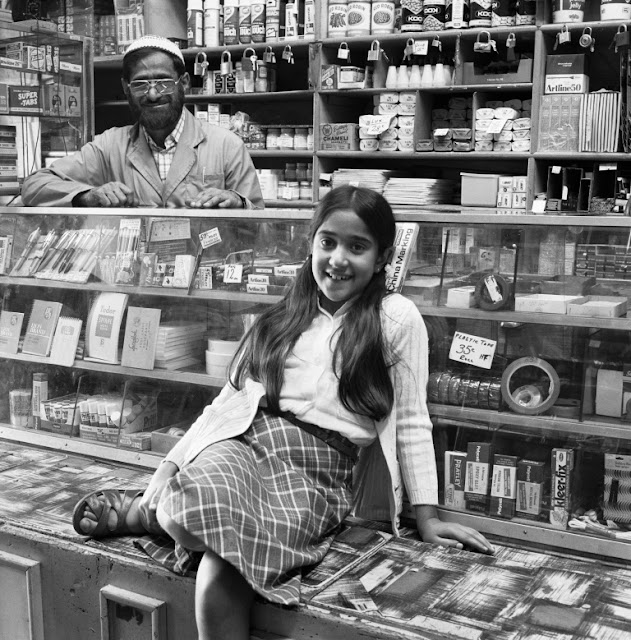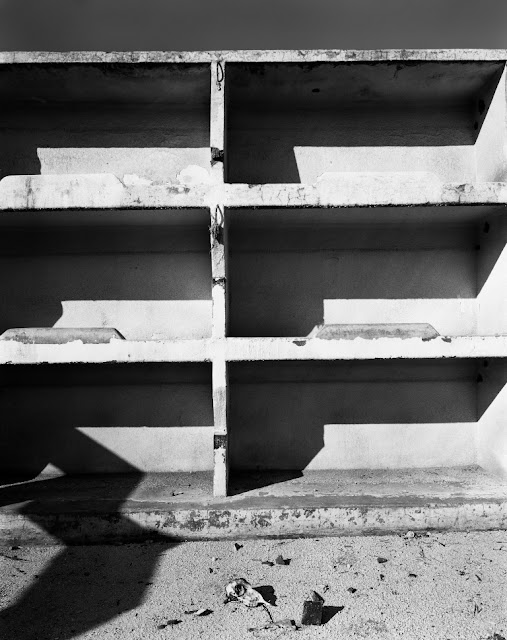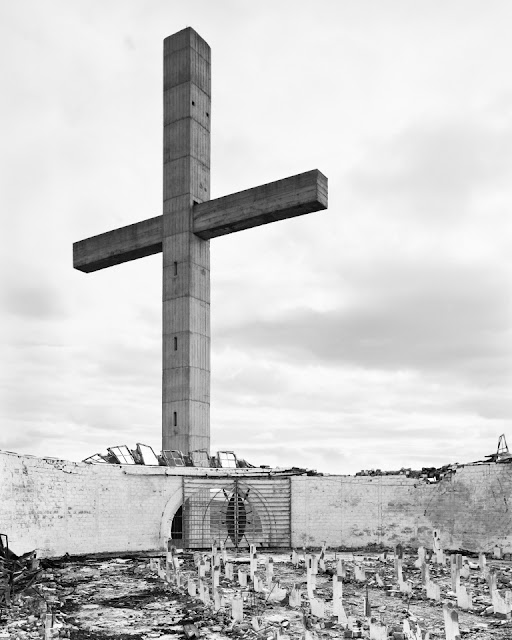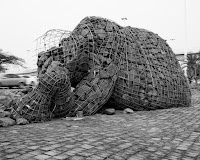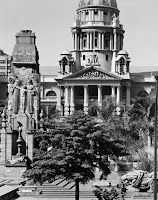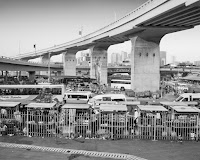| Photo Credit: Mandisa Buthelezi |
This is a Visual Literacy learning module compiled by Durban Centre for Photography (DCP) and osmosisliza, using David Goldblatt's exhibition “Structures of Dominion and Democracy” as a case study. This blog post is aimed at improving your skills for reading a photograph (decode), so that you can better understand how to make (encode) a photograph.
In
this
Visual Literacy module we will use 6 of David Goldblatt's (DG) photographs
for your Visual Literacy exercises, guided through 4 steps.
STEP 1:
What is your Social, Political and Cultural identity?
Before you make the time and read these photographs through a subjective response to position yourself in the frame, do the following group activity. In this group activity you will be interviewed and your responses will be presented to the entire group through the "eyes" of the interviewer. To start analyzing,
describing and interpreting a photograph, it is important that you draw from your own
personal perspective and social, political and cultural framework of knowledge. With this activity it is intended that you will find out more about what you know about your Social + Political + Cultural Identity values, through others.
Here is a pertinent quote to consider by David Goldblatt: "In the belief that in what we build we express
much about what we value, I have looked at South African structures as
declarations of our value systems, our ethos".
| David Golblatt by Mandisa Buthelezi |
(i) Interview (10 minutes per person)
Pair up with a learner. You will interview each
other. The interviewer can use the questions below to help the interviewee unpack their “Social + Political + Cultural ID”. The interviewee is required to articulate their personal perspectives through
experiences, thoughts, opinions, curiosities and observations had from present
and past experiences. Whilst interviewing it
is important to make handwritten notes about the conversations had.
• Who are the people/community you associate yourself with? Why?
• What excites and concerns you about society today? Why?
• What excites and concerns you about historical circumstances today? Why?
• What are the cultural practices that influence your life today?
• Why do they matter to you?
• How does your way of being relate to others for society to progress?
• What are you doing to make change?
(ii) Report back to the group (5 minutes per person in the group)
Each interviewer will now report back to the entire group what they 'heard' and wrote down. After this presentation allow the interviewee to agree, expand and disagree with the way the interviewer interpreted their statements.
(iii) Summary of parts to make a whole (10 minutes)
The facilitator opens the floor for discussion as the group identifies "sameness" and "difference" amoungst learners. What are the social, political and cultural differences and similarities that bind and separate us?
STEP 2:
Reading photographs through a subjective response...You as mirror and reflection.
How is your social + political + cultural ID "mirrored or reflected" in the photographs? Use the conversational and personal perspectives 'discovered' above to read the photographs below through the following questions:
• What do you see in the photograph? (Name and describe the objects, people, landscapes etc).
• What does what you see in the photograph mean to you?
• What does what you see in the photograph mean to you?
• What emotions or memories are provoked?
• Where are your eyes drawn to in the photograph? What stands out? Why?
photograph_1
photograph_2
photograph_3
photograph_4
photograph_5
photograph_6
Ask yourself:
"Do I need more information and facts know more, so I can see more...? Where can I find them?
"Do I need more information and facts know more, so I can see more...? Where can I find them?
Peter McKenzie (Curator) writes about the exhibition: "This kind of art entails a priori of understanding of certain political acts which justify the image as art... We live in the landscape of apartheid, both part and apart. As much as we are blinkered to the illusion of a past through the deeply divided experience of SA’s. Socially Politically and culturally the past like a spectre reaches into the present and in its long reach debilitates all attempts at any kind of the illusive notion of social cohesion. "
(i) Read DG's artist statement and the KZNSA exhibition statement here.
(ii) Have you Googled David Goldblatt?
Here are some links to find out more about DG's history and personal perspective as a photographer, as well as other writings on this body of work: "Structures of Dominion and Democracy" :
Here are some pdf's to download.
(iii) Captions: The written text that explains the "Who, When, Where..." Captions
are informative text that sit below the image and give the photograph a
context to allow the viewer to get a better understanding of how the
contents in the photo relate to an event, a place, a person, a history
or a incident. Most captions draw attention to something in the image
that is not obvious, such as its relevance to the text. The caption for
each photograph offers information we would not otherwise know from
viewing the photograph.
Ask yourself:
• How do these new details impact the way you look at the photograph?
• How does the caption inform the photograph?
(Iv) Title of the exhibition: "Structures of Dominion and Democracy"
| Photo Credit Mandisa Buthelezi |
David Golblatt says of 'structures': "For as long as building or structures is, it may "tell" something of the needs, imperatives and values of those who put it there, of those who use it, and of the ideologies upon which their beliefs and lives may have been contingent ".
Look at what the words in the title of the exhibition mean? Let's unpack the definitions of each word and then regard how they are used in the context of the exhibition alongside DG's personal perspective (resources above). Consider how these words position DG as Documentary Photographer.
STRUCTURES (Dictionary definition)
- the arrangement of and relations between the
parts or elements of something complex
- the quality of being organized
- a building or other object constructed from
several parts
- construct
or arrange according to a plan; give a pattern or organization to.
DEMOCRACY (Dictionary definition)
DOMINION (Dictionary definition)
- another term for domination – ownership and
control of property
-
the power or right of governing and controlling;
- sovereign
authority, a person or group who has supreme power or authority.
- rule; control; domination.
- a territory, usually of considerable size, in which a single
ruler-ship holds sway.
lands or domains subject to sovereignty or
control
- the
practice or principles of social equality
- straddles two distinct era in our history
- socially engaged art, highlighting issues of representation and commitment to offering a way of understanding the present because of the past.
Curator Peter McKenzie writes: "This kind of art entails a priori of understanding of certain political acts which justify the image as art...
We live in the landscape of apartheid, both part and apart.
As much as we are blinkered to the illusion of a past through the deeply
divided experience of SA’s. Socially
Politically and culturally the past like a spectre reaches into the present and
in its long reach debilitates all attempts at any kind of the illusive notion
of social cohesion... these visual images arecontemporary visual vernaculars whos voive interface, comment and catalyse a possibility of understanding the present
"
Now think about the following and discuss your thoughts as a group:
• Why did David Goldblatt make these photographs?
• What are his beliefs?
• What is his message?
• What is his social intention?
• What is his social intention?
 |
| Screenshot from video: Conversations with David Goldblatt. Photo Credit: Mandisa Buthelezi. |
STEP 4:
Re-look, re-consider and re-read.
You have been given more “clues” in step 3 to help you understand the context of the photograph and the photographers "eye". Now that you know more … will you see more?
Re-look at the photographs… re-think... re-visit...re-consider... re-read...
Draw new conclusions, apply new knowledge to new situations, make more informed observations. Focus now on what do you think the photographer wants you to see, regard and imagine now that you know more? DESCRIBE + ANALYSE + INTERPRET the photographs again through a set of new questions posed, that go beyond the collection of personal facts. Click on the links below (Photographs_1-6) to go to the pdf documents in Google Drive, and then answer the questions in the pdf documents.
Re-look at the photographs… re-think... re-visit...re-consider... re-read...
Draw new conclusions, apply new knowledge to new situations, make more informed observations. Focus now on what do you think the photographer wants you to see, regard and imagine now that you know more? DESCRIBE + ANALYSE + INTERPRET the photographs again through a set of new questions posed, that go beyond the collection of personal facts. Click on the links below (Photographs_1-6) to go to the pdf documents in Google Drive, and then answer the questions in the pdf documents.
Photograph_4: click here
Photograph_6: click here


